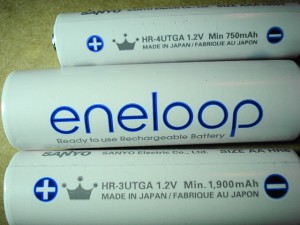So you have some Eneloop NiMH batteries huh? And it’s when they need charging that some questions arise? In that case, you’re in the right place since I have the best tips for Eneloop battery charging that you’re likely to find!
The Cells Themselves
Eneloop batteries are great.
- They’re made by Sanyo, so they have a quality reputation to uphold.
- They have very low self discharge, meaning they can sit for long periods of non-use and retain up to 80% of their capacity.
- Speaking of capacity; 2000 mAh for AA and 750 mAh for AAA is pretty standard for nickel metal hydride cells.
- No memory effect — so frequent charging isn’t much of an issue
Conflicting Health Information
Here’s where things get tricky. Unless you enjoy putting your rechargeable batteries through the grinder and replacing them once a year, most users like to treat them kindly hoping that, in return, the batteries will reward them with unflinching service. The conflicting information is centered around what occurs after the cells are depleted, prompting the user to recharge them again.
Assuming you’re using a quality charger featuring variable levels of charge current, this is where the plot thickens! First of all, Eneloops (or any rechargeables for that matter) don’t enjoy being overcharged. Yes, the charger, whether it’s a La Crosse, Maha, or Nitecore, will usually feature accurate detection methods of knowing when the cell has reached maximum voltage…it MIGHT miss the cue!
The Plot Thickens
Okay, so here’s what happens. Most of the chargers noted above will allow you to charge your Eneloops at either 200, 500, 700, and/or 1000 mA currents (your charger may vary). When you set the unit to 200 mA, you’re actually charging at a 0.1C rate. A 0.5C rate = 1000mA. What is crucial here, is when the charging cycle nears completion, the cell voltage drops. The charger waits for this drop, then terminates the charge. The inconsistency here, is when charging slowly (at 200 mA for example) the voltage drop is more subtle and depending on the cells’ age, the charger might miss it. This would cause the battery to then go into an overcharge mode. Although not immediately dangerous, but if you were unaware and allowed this to happen frequently, the cell’s life would be dramatically shortened. Newer cells being charged at 200 mA present a sharper drop, so there’s less chance of the charger missing it.
Then Again…is Too High Too Much Too Often?
On the other end of the charging spectrum, is a unit in which the default rate is 1000 mA (as in the case of the Maha). Most users of the Maha C9000 (for instance) prefer the default setting and claim it’s been perfectly fine with their Eneloops. However, having said that, it’s widely known that “fast chargers” tend to ‘bake’ the batteries by applying too high a current, too quickly. The chemical composition of a rechargeable battery is not such that it can withstand this type of charging too often. Therefore you must consider the possibilities when the internal temperature of the charging batteries gets too high.
Bottom Line — Know Your Charger
With the older La Crosse BC-700, it’s my belief that the 700 mA rate is quite safe, and reasonably quick. Even with this unit, some prefer to set it at 500 mA. These two settings, regardless of which charger you use, are considered moderately good. As referenced above, the Maha charger has a very high default setting which seems to please its owners just fine.
It stands to reason that as your cells age, the composition changes. We, as humans, do the same thing!! So, too slow may cause complications. Meanwhile, too fast, although great at first, is not sustainable over long periods either.
If you have questions or comments regarding this post – please let me know in the spaces below!
For a terrific selection of Eneloop batteries, follow this link!!









Great post and a fascinating read!!
Thanks very much 🙂